Chapter 2: Scoping Requirements
New Construction
This guide provides an introduction to the scoping requirements that form the basis for the Department of Justice’s 2010 ADA Standards and the Department of Transportation's ADA Standards and is not intended to be comprehensive or used as a stand-alone technical guide to those requirements. Users of this guide must familiarize themselves with the specific scoping requirements that apply to each element, building, facility, or site that is subject to the Standards adopted to implement titles II and III of the ADA.
Although this guide focuses on the provisions of Chapter 2 of the ADA Accessibility Guidelines, which form the basis of the DOJ and DOT ADA Standards, the 2010 Standards adopted by DOJ incorporate regulatory language that modifies or augments a number of those provisions, or address certain occupancies that are not specifically addressed in Chapter 2, and these regulatory provisions must be read in conjunction with Chapter 2 to ensure an accurate understanding of the legal requirements. Readers should become familiar with how the 2010 Standards modify the requirements in Chapter 2 and should not assume that by reading the provisions of Chapter 2 alone they will have all the information and perspective they need to achieve compliance with the 2010 Standards.
Scoping Requirements
Requirements in Chapter 2 indicate which elements and spaces must be accessible on a site or in a facility (the scope of coverage). These “scoping” requirements apply technical provisions in Chapters 3 – 10 to those covered elements and spaces provided on a site.
Applicable building codes, design practices, and other factors determine the elements and spaces required for a site, including parking, means of egress, and plumbing fixtures. The ADA Standards, on the other hand, specify the elements and spaces provided that must be accessible.
Application [§201]
The ADA Standards apply to the various types of facilities subject to the ADA, from simple structures to complex, multi-building sites such as university campuses and airports. Requirements in the standards apply to both exterior and interior spaces and elements provided on a site, usually without distinction. Provisions for parking, for example, apply equally to exterior lots and to parking garages. The standards cover permanent facilities and temporary facilities (other than those used in construction), such as reviewing stands, stages, portable toilets, and temporary classrooms.
In new construction, all areas must be fully accessible, including multiple spaces of the same type, unless otherwise specified. Areas not required to be fully accessible include:
Example: Retail Facility
This example of a retail facility shows how scoping requirements for certain elements and spaces (sales counters and fitting rooms) apply and indicates employee work areas.
Exception Based on Structural Impracticability in DOJ’s 2010 ADA Standards and DOT's ADA Regulations
DOJ’s 2010 ADA Standards and DOT's ADA regulations specify that full compliance is not required in new construction in rare circumstances where unique characteristics of terrain make the incorporation of accessibility features “structurally impracticable.” In such a case, the new construction requirements apply except where the responsible entity can demonstrate that it is structurally impracticable to meet those requirements. This exception is very narrow and should not be used in cases of merely hilly terrain.
Even in those circumstances where the exception applies, portions of a facility that can be made accessible must still be made accessible. In addition, access must be provided for individuals with other types of disabilities, even if it may be structurally impracticable to provide access to individuals who use wheelchairs.
This exception is found in DOJ’s 2010 Standards at §35.151(a) for title II and §36.401(c) for title III and in DOT’s ADA regulations at §37.41(b).
General Exceptions [§203]
These structures and spaces are fully exempt from the standards and are not required to be accessible or on an accessible route:
Construction Sites (§203.2)
Structures directly associated with the actual processes of construction and portable toilets used only by construction workers
Examples: scaffolding, bridging, materials hoists, construction trailers
Areas Raised for Security/ Safety (§203.3)
Areas raised primarily for purposes of security or life/ fire safety
Examples: life guard stands, fire towers, and prison guard towers
Raised Work Areas (§203.9)
Employee work areas under 300 s.f. that are elevated at least 7” as an essential functional condition of the space (excluding raised courtroom stations)
Example: Work areas with equipment/ machinery that must be operated from a platform
Limited Access Spaces (§203.4)
Spaces accessed only by ladders, catwalks, crawl spaces, or very narrow passageways
Examples: lighting/ equipment catwalks at stages and performing areas, platforms served only by ladder
Machinery Spaces (§203.5)
Spaces used only by service personnel for maintenance, repair, or occasional monitoring of equipment
Examples: elevator pits/ penthouses, mechanical/ electrical/ communications equipment rooms, water or sewage treatment pump rooms, electric substations, and transformer vault
Single Occupant Structures (§203.6)
Single occupant structures accessed only by below-grade passageways or elevated above standard curb height
Examples: toll booths that are accessed by underground tunnels or elevated above curb height, such as those serving dedicated truck lanes
Detention/Correctional and Residential Facilities (§203.7 and §203.8)
Common use spaces in detention/ correctional facilities or residential facilities that do not serve accessible cells or dwelling units are exempt.
Certain Sports/ Recreation and Other Structures (§203.10 - §203.14)
These structures and spaces are also exempt:
-
raised structures used solely for refereeing, judging, or scoring a sport
-
raised boxing/ wrestling rings
-
water slides and raised diving boards/ platforms
-
animal containment areas not open to the public
Employee Work Areas [§203.9]
Title I of the ADA prohibits discrimination based on disability in the workplace. Information on the ADA and equal opportunities in hiring and employment, including reasonable accommodations for employees, is available from the Equal Employment Opportunity Commission at (800) 669‒4000 (v), (800) 669‒6820 (TTY), or www.eeoc.gov.
The ADA Standards require a more limited level of accessibility in employee work areas. At a minimum, areas used only by employees as work areas must meet requirements for:
-
access to approach, entry, and exit the work area (§203.9)
-
accessible means of egress (§207.1)
-
wiring for visible alarms in areas served by audible alarms (§215.3)
-
accessible common use circulation paths in most work areas of at least 1,000 sq.ft. (§206.2.8)
Other requirements, including those for turning space, do not apply to areas used only by employees for work.
These provisions apply to those areas where only work is performed by employees. Spaces not used for work, including employee restrooms, locker rooms, break rooms, cafeterias, and parking, must be fully accessible. Some public use spaces also function as work spaces, such as medical exam rooms and classrooms. These spaces must be fully accessible for public use, but elements within used only by employees for work are not required to comply.
Recommendation: Although areas used only by employees for work are not required to be fully accessible, consider designing such areas to include non-required turning spaces, and provide accessible elements whenever possible. Under the ADA, employees with disabilities are entitled to reasonable accommodations in the workplace. Accommodations can include alterations to spaces within the facility. Designing employee work areas to be more accessible at the outset will eliminate or reduce the need for more costly retrofits in providing reasonable accommodations for employees with disabilities.
Access to Approach, Enter, and Exit Work Areas
Access for “approach, entry, and exit” requires a connecting accessible route to the work area and a compliant entrance, including entry doors or gates, plus wheelchair space in the work area. Work areas must also be served by an accessible means of egress, as required by the International Building Code.
Access for Approach, Entry, and Exit
Common Use Circulation Paths in Employee Work Areas [§206.2.8]
Common use circulation paths must be accessible in work areas 1,000 square feet or more in size (as defined by permanently installed partitions, counters, casework, or furnishings). This requirement facilitates access to individual work stations within a space.
Common Use Circulation Paths
Work Area Circulation Paths: Exceptions
Common use circulation paths are required to be accessible except:
-
in work areas below 1,000 sq. ft. in size
-
in work areas fully exposed to the weather (regardless of size)
-
where they are integral to work equipment
Circulation Paths Serving Exempted Spaces [§203]
Portions of common use circulation paths serving exempt spaces within a work area are not required to comply, including routes to or within:
-
machinery spaces used only by service personnel;
-
spaces accessed only by ladders, catwalks, crawl spaces, or very narrow passageways;
-
employee work areas under 300 sq. ft. that are elevated at least 7” as an essential functional condition of the space (excluding raised courtroom stations);
-
and other exempted spaces.
Wiring for Visible Alarms [§215.3]
All employee work areas served by audible fire alarms, regardless of size, must be designed to support later installation of visible alarms after construction if needed. In new construction, alarm systems are typically provided with sufficient power resources to support the addition of strobes where they are needed to accommodate an employee who cannot hear the audible alarm.
Recommendation: In facilities where an above-average number of employees with hearing impairments is likely, such as in the offices of a school for people who are deaf or hard of hearing, it is advisable to equip alarm systems with power capacity above the level that is typically provided in order to accommodate a greater number of visual appliances.
Scoping Requirements for Elements and Spaces [§204 – §243]
Scoping provisions for elements and spaces, which are summarized here, are further discussed with relevant technical provisions in the following chapters of this guide.
General Elements
Most scoping provisions apply to both interior and exterior elements where provided throughout facilities and sites (and are not limited to those in corridors as shown here).
Specific Spaces and Occupancies
The ADA Standards include scoping requirements specific to certain types of spaces and facilities that apply based on the intended use and design. Spaces with multiple uses must meet all applicable requirements for each use. Scoping provisions for specific spaces and occupancies address:
Transportation Facilities (§218) and Bus Stops (§209)
Assembly Areas (§221) *
Dressing, Fitting, and Locker Rooms (§222)
Medical Care and Long-Term Care Facilities (§223) *
Transient Lodging Guest Rooms (§224) *
Storage (§225)
Judicial Facilities (§231)
Detention and Correctional Facilities (§232) *
Residential Facilities (§233) *
Recreation Facilities (§234 – §243)
DOJ’s 2010 ADA Standards incorporate regulatory language that modifies or augments a number of these provisions (noted with an asterisk) and also set forth additional requirements for spaces and facilities provided in housing at a place of education, social service center establishments, and curb ramps.
Common Questions
Are all public use and common use areas required to be accessible?
All areas of facilities, including public and common use areas, are required to be accessible in new construction except those that are specifically exempt (e.g., certain types of limited use or raised spaces) or that are covered by provisions that require only a specified portion to comply (e.g., transient lodging guest rooms and patient bedrooms). All other rooms and spaces, including multiple ones of the same type, such as patient exam rooms, classrooms, and courtrooms, are required to be accessible. Employee work areas, however, are not required to be fully accessible.
Can access be provided after construction based on need?
Access required by the ADA Standards must be put in place and ready for use as part of construction. This is required in all but a few specified instances, such as:
-
Toilet and bathrooms in residential dwelling units or accessed through an individual’s private office for his or her exclusive use are not required to be built with certain specifically enumerated access features, such as grab bars and lavatory clearances, if they are built according to criteria that will facilitate later installation or adaptation, such as reinforcement for grab bars and removable vanity cabinets.
-
Vertical access to work stations in courtrooms, such as judges’ benches, can be provided after construction if space and other requirements are met to ease later installation of necessary ramps or lifts.
Are employee restrooms and break rooms required to be accessible?
Yes, spaces used by employees for purposes other than work, including restrooms, break rooms, locker rooms, lounges, and parking must be fully accessible. Areas used only by employees for work are not required to be fully accessible but must be connected by accessible routes and means of egress for approach, entry, and exit and have wiring to support visual alarms if served by audible alarms. Also, circulation paths must be accessible in work areas at least 1,000 square feet in size.
What does access for “approach, entry, and exit” to employee work areas require?
Access for individuals with disabilities to “approach, entry, and exit” employee work areas requires that the following be provided at a minimum: an accessible route to the work area, a compliant entrance, including any entry door or gate, to the work area, and wheelchair space (30 inches by 48 inches minimum) within the work area. Work areas also must also meet referenced requirements in the International Building Code for accessible means of egress and also have wiring to support later installation of visual alarm appliances.
Alterations and Additions
This guide provides an introduction to the scoping requirements that form the basis for the Department of Justice’s 2010 ADA Standards and the Department of Transportation's ADA Standards and is not intended to be comprehensive or used as a stand-alone technical guide to those requirements. Users of this guide must familiarize themselves with the specific scoping requirements that apply to each element, building, facility, or site that is subject to the Standards adopted to implement titles II and III of the ADA. See the introduction to the guide on “ADA Scoping: New Construction” for further discussion.
General [§202.1]
Additions and alterations undertaken at existing facilities are covered by the ADA Standards. The extent of application is largely determined by a project’s scope of work as the standards apply to those elements or spaces that are altered or added. Additional requirements apply to projects that affect or could affect the usability of, or access to, an area containing a primary function.
Additions [§202.2]
Projects that increase, expand, or extend a facility’s gross floor area or height of a facility are considered additions (as defined in §106.5) and must comply with the requirements of the standards applicable to new construction. Existing elements and spaces affected by an addition are treated as alterations and qualify for certain allowances or exceptions that are not permitted in new construction.
Application of the Standards in Additions
Alterations [§202.3]
Alterations are defined in the standards (§106.5) as “a change in a building or facility that affects or could affect the usability of a building or facility or portion thereof.” Many types of projects are covered as “alterations,” including remodeling, renovation, rehabilitation, reconstruction, restoration, resurfacing of circulation paths or vehicular ways, and changes or rearrangement of structural parts, elements, or walls. Normal maintenance, reroofing, painting or wallpapering, or changes to mechanical and electrical systems are not considered alterations unless they affect a facility’s usability. For example, a project limited to an HVAC system that includes the addition of thermostats would affect a facility’s usability because it involves elements (operable parts) covered by the standards.
The standards ensure that the opportunities for accessibility presented by an alteration are taken. How and to what extent the standards apply is determined by the scope of a project and the elements and spaces altered. Only those elements or spaces altered are required to comply, but alterations made to areas containing a primary function (a major activity for which a facility is intended) also require an accessible path of travel.
Application of the Standards in Alterations
If alterations are limited only to elements in a room or space, then the standards apply only to the elements altered. Similarly, where spaces are altered, the standards apply to those spaces that are altered. If a room or space is completely altered (or built new as part of an alteration), the entire room or space is fully subject to the standards. Compliance is required to the extent that it is technically feasible.
Example: Toilet Room Alterations
In a restroom project involving alterations to the toilet, grab bars, faucet controls, and mirror, the standards apply to these elements but not to those that remain unaltered. In more extensive projects where additional elements are altered, application of the standards is greater, commensurate with the scope of work.

Recommendation: While only those elements altered are required to comply, it is advisable to maximize opportunities for accessibility in alterations. Alteration of multiple elements in a room or space may provide a cost-effective opportunity to make the entire room or space fully accessible.
The standards do not require alterations to exceed the level of access required in new construction. For example, spaces that are exempt in new construction are also exempt in alterations.
Prohibited Reduction in Access
New construction requirements also set the baseline for any alteration that would effectively reduce existing accessibility. Alterations that reduce accessibility below the level that would be required in new construction are prohibited. Reductions in access are allowed only where, and to the extent that, the minimum level required in new construction is exceeded. For example, if an alteration will reduce the number of parking spaces on a site, accessible parking spaces can be proportionately reduced as long as the minimum required in new construction (based on the parking facility’s new total) is met. Elements that are not required by the standards to be provided for accessibility, such as phones, can be completely removed from a site.
Special Provisions for Alterations
The standards apply the same requirements used in new construction to alterations but also include provisions unique to alterations. Some provisions clarify application, while others are structured as exceptions that limit coverage or relax technical criteria under certain conditions. Located throughout the standards at the relevant scoping or technical requirement, these provisions and exceptions are distinguished by references to “alterations” or “existing facilities.”
An accessible route to stories and mezzanines is required in alterations (or additions) where stairs or escalators are added where none existed previously and major structural modifications are necessary (§206.2.3.1) (or as needed to provide an accessible path of travel to an altered primary function area if not disproportionate to the cost (§202.4)), unless the building is exempt from the requirement for access between stories.
If elevators are altered, all cars programmed to respond to the same call control must be similarly modified (§206.6.1).
Compliant fire alarm systems are required only in alterations where fire alarm systems are installed new, replaced, or upgraded (§215.1, Ex. 1).
Slightly steeper running slopes are permitted for short ramps (maximum 6” rise) where space is limited (§405.2, Ex.).
Full handrail extensions at stairs are not required where they would project hazardously into circulation paths (§505.10, Ex. 3).
Technical Infeasibility
Compliance in an alteration is not required where it is “technically infeasible.” The term is defined as “something that has little likelihood of being accomplished because existing structural conditions would require removing or altering a load-bearing member that is an essential part of the structural frame; or because other existing physical or site constraints prohibit modification or addition of elements, spaces, or features that are in full and strict compliance with the minimum requirements.”
Where technical infeasibility is encountered, compliance is still required to the maximum extent technically feasible.
Example of Technical Infeasibility
It may be technically infeasible in an alteration to enlarge a toilet room confined in size by structural supports, elevator shafts, mechanical rooms and chases, stairways, or required egress routes not affected by the project. In this case, the toilet room must be sized and other requirements, including those for plumbed fixtures, must be met to the maximum extent technically feasible. However, the concept of technical infeasibility remains relative to the planned scope of work. If the entire building is significantly renovated or gutted, constraints of this type would likely not exist.
Other examples where compliance could potentially be technically infeasible include:
-
conflicts with applicable building, plumbing, life safety or other codes (such as when combining two toilet stalls to create an accessible stall would violate the plumbing code’s required fixture count);
-
meeting slope requirements on existing developed sites located on steep terrain where necessary re-grading and other design solutions are not feasible; or
-
work that would impact load-bearing walls and other essential components of the structural frame, including structural reinforcement of the floor slab.
Alterations Affecting Primary Function Areas [§202.4]
Additional requirements apply when alterations are made to areas containing a “primary function,” which is a major activity intended for a facility. Examples of primary function areas include dining areas of a restaurant, retail space in a store, exam rooms in a doctor’s office, classrooms in a school, and offices and other work areas where the activities of a covered entity are carried out. Spaces not considered primary function areas include entrances, corridors, restrooms, break rooms, employee locker rooms, and mechanical or electrical closets. Restrooms are not primary function areas unless their provision is the primary purpose of a facility, such as a highway rest stop. DOJ’s 2010 ADA Standards and DOT’s ADA regulations contain detailed provisions on alterations to primary function areas that must be applied in addition to section 202.4.
Accessible Path of Travel
When alterations are made to a primary function area, an accessible path of travel to the area must be provided. The accessible path of travel must extend from the altered primary function area to site arrival points, including public sidewalks and parking and passenger loading zones provided on the site. The path of travel also includes access to restrooms, telephones, and drinking fountains, where provided to serve the primary function area. In leased facilities, alterations made by a tenant to primary function areas that only the tenant occupies do not trigger a path of travel obligation upon the landlord with respect to areas of the facility under the landlord’s authority if those areas are not otherwise being altered.
Disproportionality (20%)
The accessible path of travel is required to the extent that it is not “disproportionate” to the total cost. Regulations implementing the standards define “disproportionate” as exceeding 20% of the total cost of alterations to the primary function area. The 20% cap applies only to costs associated with the accessible path of travel, including an accessible route to the primary function area from site arrival points, entrances, and retrofits to restrooms, telephones, and drinking fountains.
Prioritization
Compliance is required up to the point the 20% cost cap is reached, even where it does not result in a fully accessible path of travel. Where costs exceed this cap, compliance should be prioritized in this order:
1. an accessible entrance
2. an accessible route to the primary function area
3. restroom access
4. an accessible telephone
5. an accessible drinking fountain
6. access to other elements such as parking and storage
The requirements for alterations to primary function areas are found in DOJ’s ADA Standards at 28 CFR §35.151(b) (title II) and 28 CFR §36.403 (title III) and in DOT’s ADA Regulation at 49 CFR §37.43.
Accessible Path of Travel
Alterations to Qualified Historic Facilities [§202.5]
The standards contain specific provisions for qualified historic facilities which are defined as buildings or facilities that are “listed in or eligible for listing in the National Register of Historic Places or designated as historic under an appropriate State or local law.” Alterations to qualified historic facilities must comply with section 202.5 to the maximum extent feasible. If it is not feasible to provide physical access to an historic property in a manner that will not threaten or destroy the historic significance of the building or facility, alternative methods of access are permitted by DOJ’s ADA Standards (28 CFR 35.151(b)(3)(ii) and 28 CFR 36.405(b)).
Like other existing facilities, the requirements for alterations apply in relation to the scope of work. Alterations provisions and exceptions, including those based on technical infeasibility, and requirements for path of travel to primary function areas, apply to historic facilities with exceptions for circumstances where compliance with the standards would threaten or destroy the historic integrity or significance of a facility as determined by the appropriate State Historic Preservation Official or Advisory Council on Historic Preservation. These exceptions apply to requirements for accessible routes (§206.2) entrances (§206.4), and toilet rooms (§213.2).
Exceptions for Qualified Historic Facilities
(where compliance would threaten or destroy a facility’s historic significance)
Common Questions
What requirements of the standards apply in an alteration?
Application of the standards in an alteration is determined by the scope of work and whether it involves areas containing a primary function. Altered elements or spaces must comply with relevant provisions of the standards except where compliance is technically infeasible. Where compliance is technically infeasible, compliance is required to the maximum extent feasible. If alterations are made to an area containing a primary function (a major activity for which a facility is intended), an accessible path of travel from the area to site arrival points, as well as the restrooms, telephones, and drinking fountains serving the area, must be made accessible as part of the work to the extent it is not “disproportionate” (more than 20% of the total cost).
How is “technical infeasibility” determined in an alteration?
Determining “technical infeasibility” requires a site-specific assessment of constraints or complications in relation to the planned scope of work. The term, as defined in the standards (§106), is intended to encompass design, site, engineering or other constraints that prohibit compliance. Examples include work that would impact a facility’s structural frame or that would conflict with applicable codes or building requirements.
Do the ADA Standards apply to existing facilities that are not subject to the alterations requirements?
DOJ’s ADA regulations address access to existing facilities that are not being altered. The regulations require removal of barriers by public accommodations (title III) and program access by state and local governments (title II). The 2010 Standards apply when architectural changes are made to facilities in order to comply with the program access requirements of title II of the ADA. In addition, the 2010 Standards are the benchmark for compliance with the title III barrier removal requirements. For more information about barrier removal and program access, visit DOJ’s website at www.ada.gov or contact the DOJ ADA Information Line at (800) 514-0301 (voice) or (800) 514-0383 (TTY).



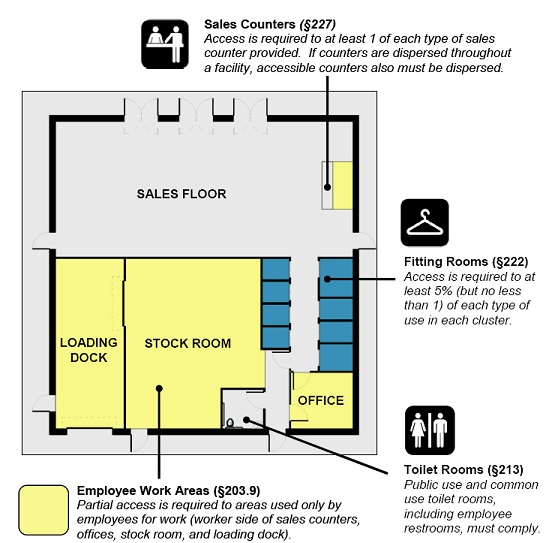

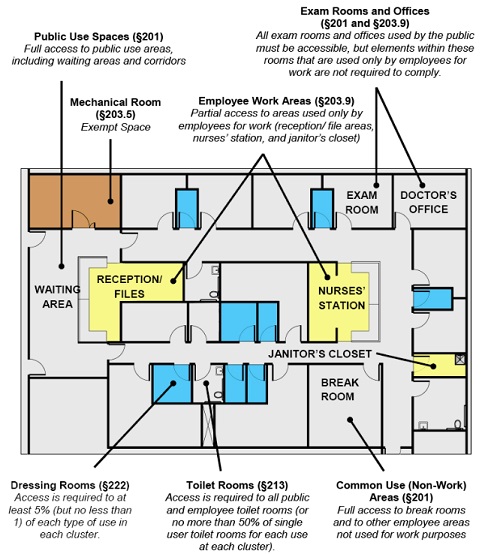










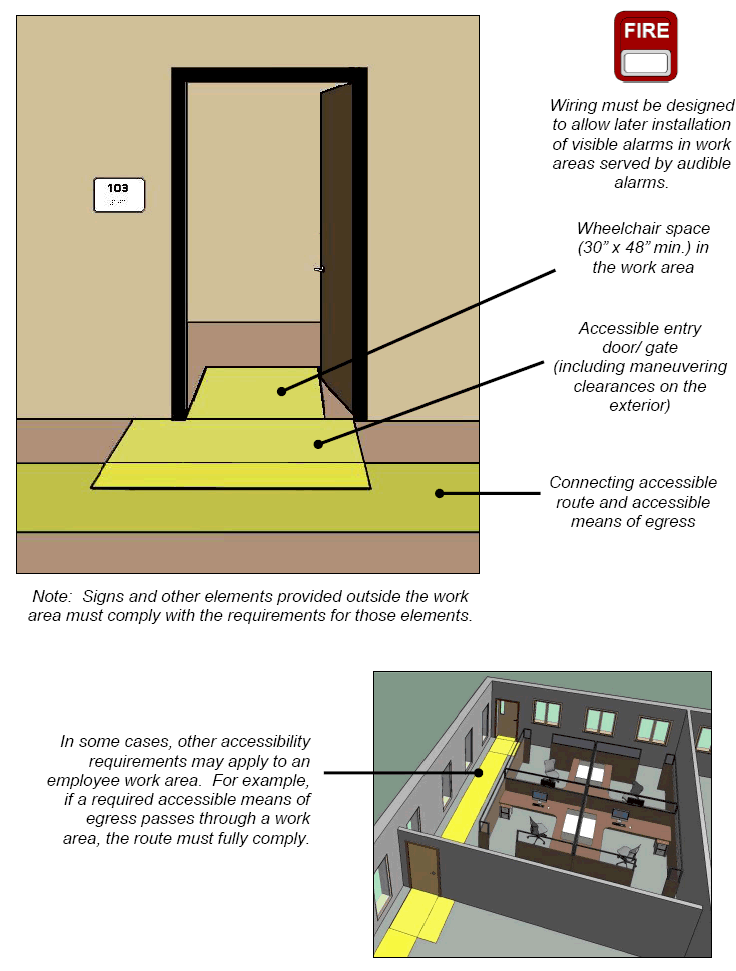
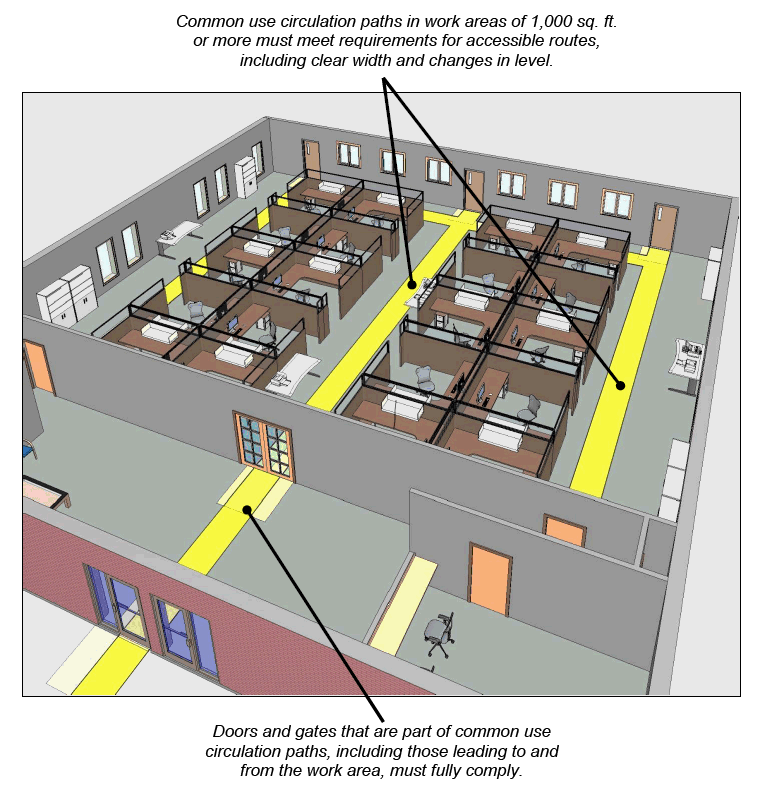
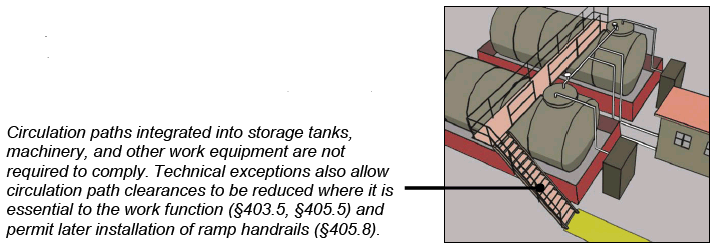



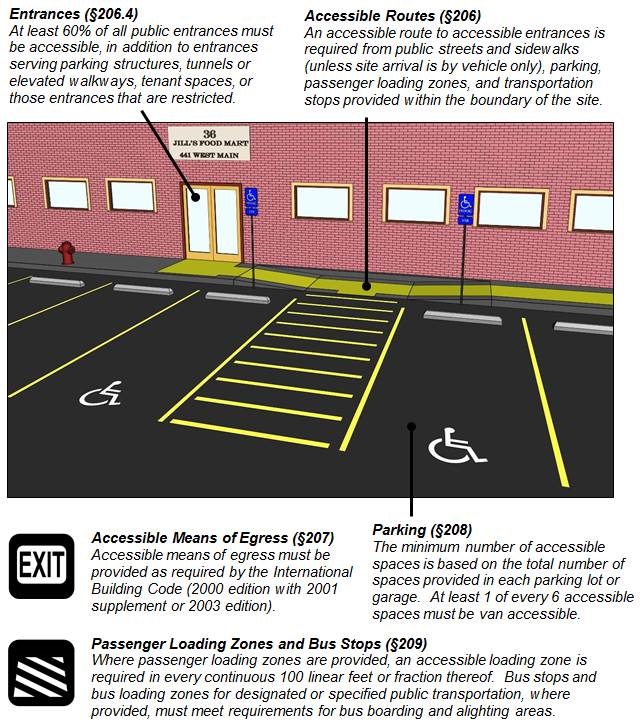
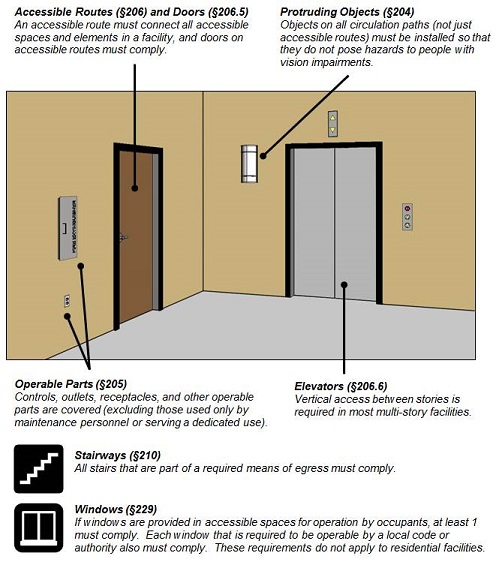
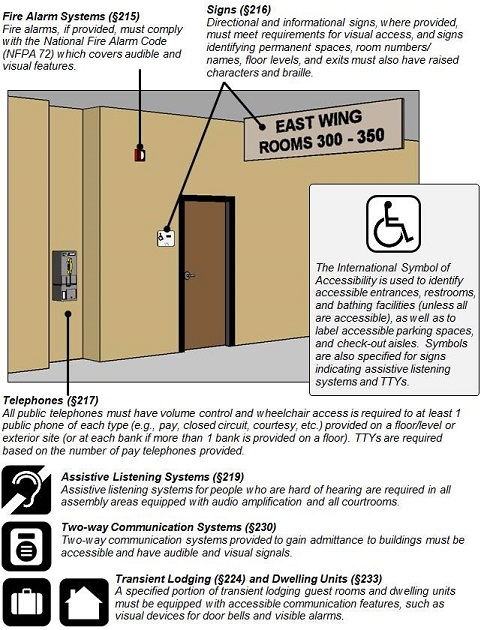
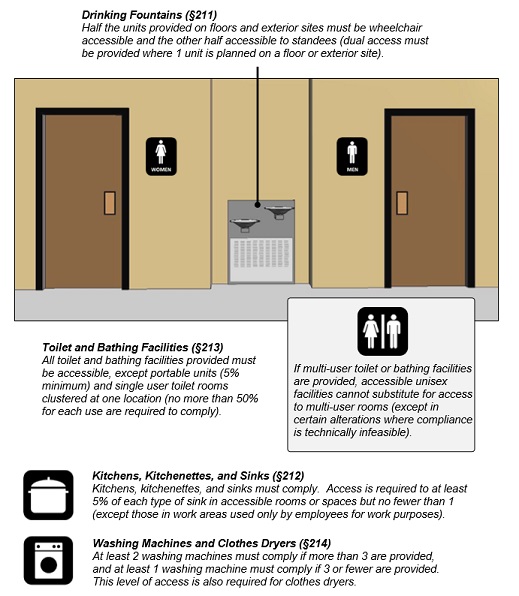
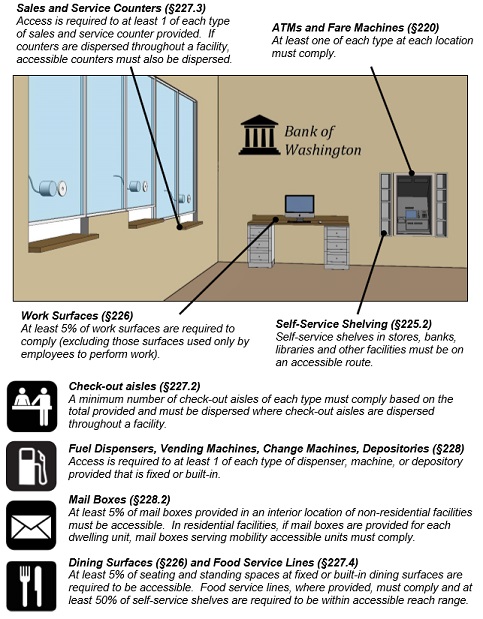












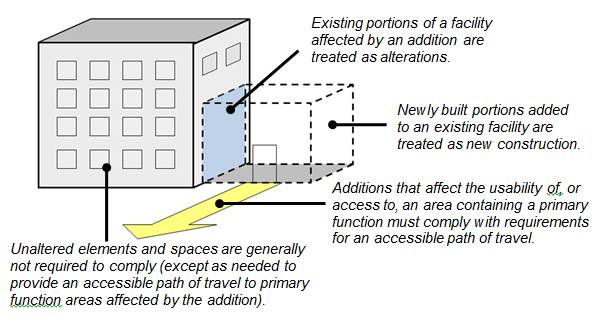
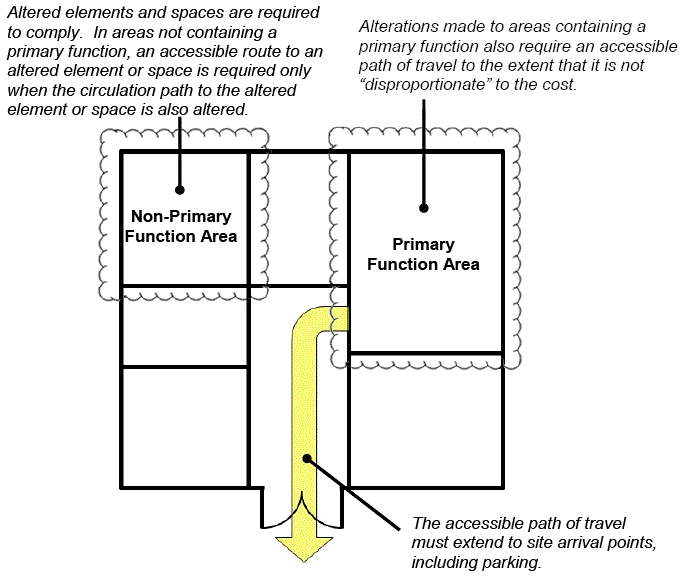
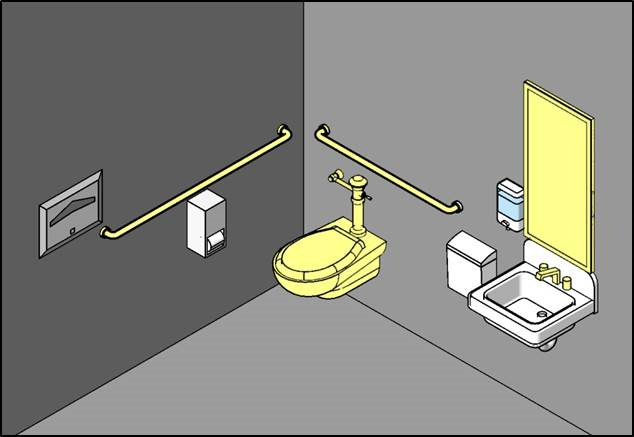
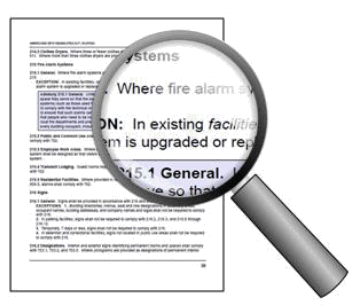





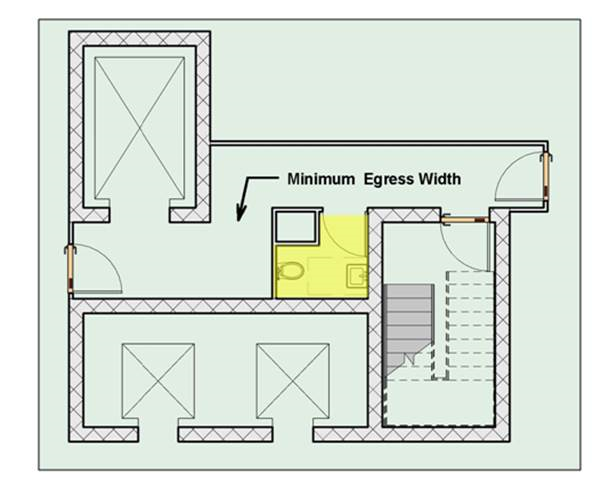
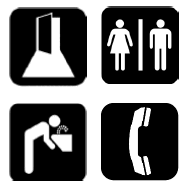
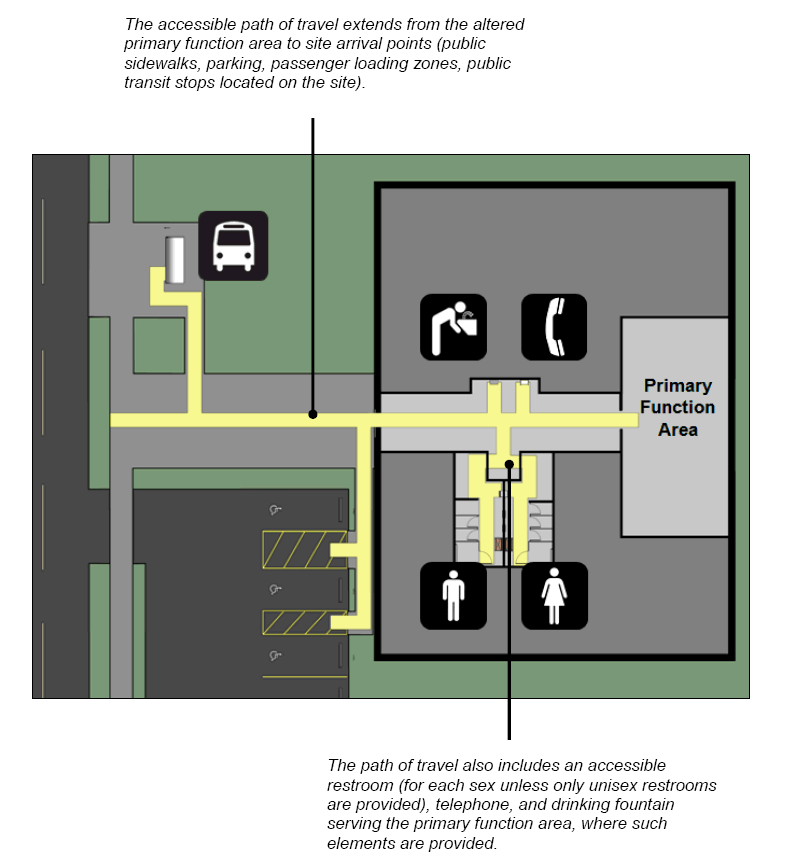

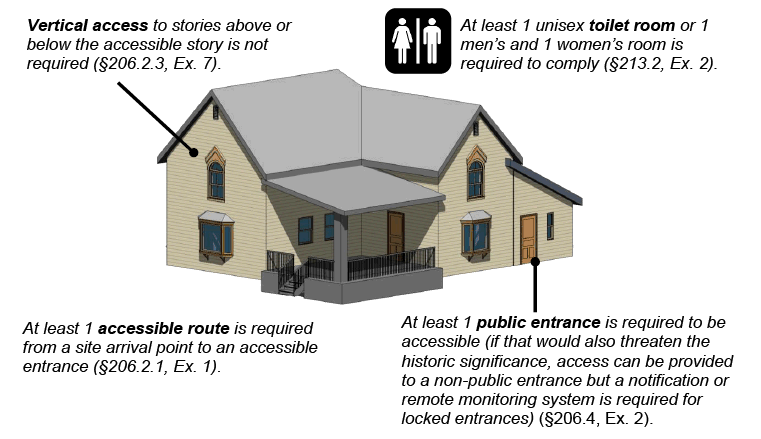

User Comments/Questions
Add Comment/Question